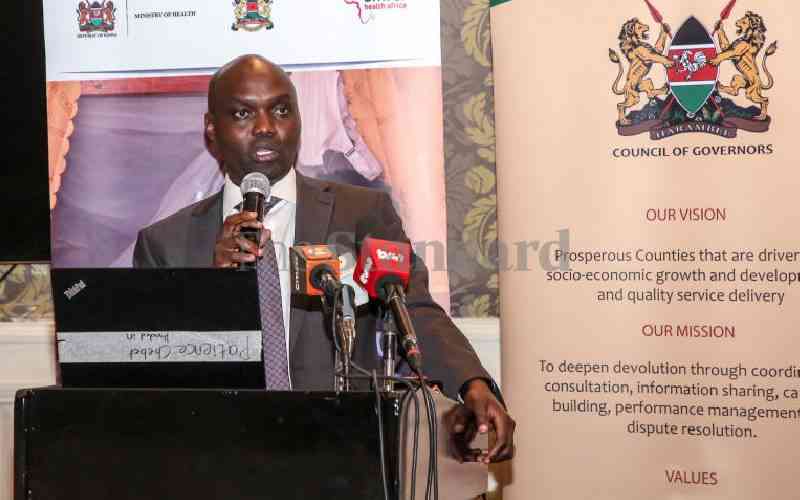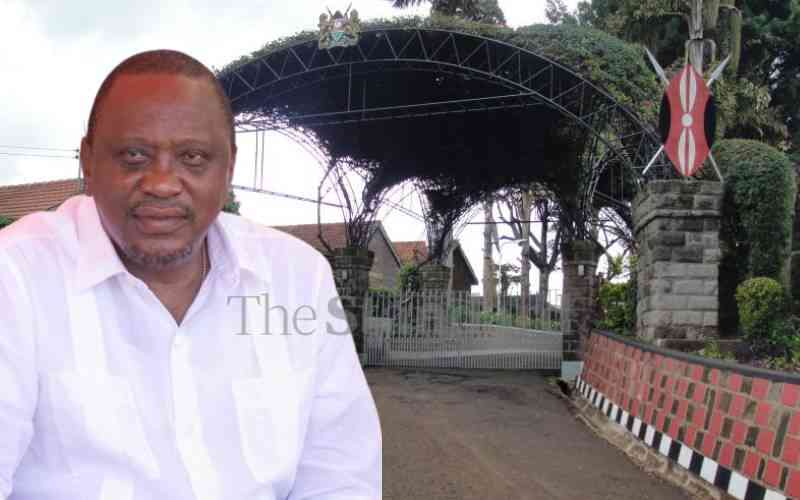 |
|
Kenya's presidents from left to right: Jomo Kenyatta, Daniel Moi, Mwai Kibaki and Uhuru Kenyatta. |
By Steve Mkawale and Protus Onyango
Kenya: Kenya has had four Presidents, the current one being a son of the first, and they all took to office different styles of governance and symbols of radiating power and authority.
President Uhuru Kenyatta exhibits the easy-going and free spirit of young ‘digital age’ national executives such as America’s Barack Obama and UK’s David Cameron. But the first two stood out in the way they exercised power and symbolised authority.
Mzee Jomo Kenyatta had his flywhisk and bakora (walking stick), and beaded cap extolling the everlasting symbolism of the colours of the Kenyan flag. His successor, Mzee Daniel Moi borrowed the symbol of authority of a man in the Kalenjin heritage — rungu (baton). Both also had their subjects bear their badges on the lapels of their coats and the red Kanu shirts and ties adorned with the colours of the national flag.
But enter Mwai Kibaki in 2002 and there was a little plainness in the way he exuded power, turning up at public functions with miniature notebooks and pen. Like the university lecturer he was in early 1960s, he would take notes as leaders spoke, then he would later, in his usual witty style respond to their exhortations and advice.
Mzee Kenyatta had a taste for traditional music, which would at times lull him to sleep in public, while Moi had a preference for not just traditional music but mass choirs belting out patriotic and religious songs.
Uhuru’s entry this year brought in a new style, with the youthful leader often patting the backs of his guests, including journalists. Embrace and long handshakes characterise his way of getting guests feel free and then the laughter itself is roaring and rocks the ribs.
Historians and leaders who have lived through the past three regimes and have had a taste of Uhuru’s agree that although Kenyans are still mesmerised by the presidency, the office has been demystified.
Gone are the days when a presidential rally was incomplete without the rallying call of ‘harambee’ goaded by the wave of rungu, bakora or flywhisk. In Moi’s harambee was followed by the shout of Nyayo! meaning walking in Mzee Kenyatta’s footsteps.
Radiated power
Under Mzee Kenyatta and Moi, Kenyans were accustomed to a President who radiated power, publicly issuing declarations and extolling the powers of ‘Black Man’s’ self-rule.
Unlike Mzee Kenyatta who was referred to as Mzee, the second President earned the name of ‘Baba wa Taifa (Father of the Nation) which was popularised by mass choirs. Kibaki appeared less moved by the trappings of power, maintained limited public appearances and seemingly showed just a little interest in praise songs.
Kenyans who had been used to the Moi era’s off-the-cuff speeches were transported to a lecture hall where Kibaki relived his Makerere University days, delivering short speeches crafted from notes extracted from his notebook.
Enter Uhuru and Kenyans now keep abreast with a digital-savvy leader through his Facebook and Twitter updates.
Leaders asked by The Counties to compare the four presidents agree Moi was the most generous and politically cunning Head of State, Mzee Kenyatta the father figure of the nation and Kibaki the aloof one.
Stay informed. Subscribe to our newsletter
It is also indisputable that Moi is a man one could count on when beset with financial difficulties although he was tough president who lived by the principle of keeping his friends close and his adversaries even closer.
Former Wundanyi MP Mwandawiro Mghanga describes Mzee Kenyatta as a patriot who loved life and presided over the best economic period in the country.
While Kenyatta was not listening to traditional dances or school choirs he would be relaxing in Mombasa where he at times swam, next to State House.
Mghanga, a former University of Nairobi student leader recalls Mzee Kenyatta had a sense of humour and loved patriotic songs from dancers visiting in Nakuru and Mombasa State Houses.
“I attended one such session in Gatundu where a group of women were singing for Kenyatta. In the course of the performances, Mbiyu Koinange, who was sleeping, woke up and told the women to leave. Teasingly, Kenyatta asked him to sing for him now that he had dismissed the women,” Mghanga says.
Though a capitalist, Mghanga explains during Kenyatta’s time, basic commodities were affordable, though he dealt ruthlessly with those who opposed him.
Veteran politician, Wilson Leitich, a former Nakuru branch Kanu Chairman describes Moi as a generous and kind person who was always willing to help people irrespective of their ethnic background.
“Mzee would invite us to State House for consultation as local leaders and we could not leave that place empty-handed. He was a cheerful giver,” recalls Leitich.
Mghanga says that Moi was not elitist, a factor that saw him embrace illiterate but shrewd people to help him entrench his rule.
“That is why people like the late Mulu Mutisya, Ezekiel Barng’etuny and Kariuki Chotara as well as educated people like late Mutula Kilonzo, Moses Wetangula and Raila Odinga worked with him,” Mghanga says.
He adds: “But whether you were a close friend to Moi, he could be with you now and fire you in the next minute through KBC radio just like he did with Philip Mbithi, former Head of Public Service.”
However, former Nakuru North MP, Koigi Wamwere who was detained by Mzee Kenyatta and Moi has some unflattering memories of the Kenya’s second Head of State.
“In August 1982 attempted coup, Moi had two days of trouble and that made him a man Kenya had never known over the years. He was ruthless in crushing rebellion,” Koigi observes.
Historian Prof Macharia Munene argues: “People did not understand Moi. They underrated him but he was calculative and decisive, a schemer who played the fool. That is how he ruled for 24 years.”
He believes Kibaki was a good planner and economist but a poor politician who did not know how to deal with a political situation and that is why he had many political problems.
Ironically, Koigi, who was freed from detention by Moi fondly describes the late Kenyatta as a no-nonsense patriot who sacrificed a lot during the struggle for independence but later left the country in political wilderness.
“Kenyatta was an excellent leader during the struggle for independence. He was charismatic, promising and a true son of Africa. But just like the biblical Moses, he took us from Egypt but failed to deliver us to Canaan. He left Kenyans in the desert,” Koigi laments.
Mghanga says Mwai Kibaki’s leadership was marked by aloofness and a non-committal style. “Kibaki allowed only his inner circle inside State House and let people do their work without necessarily through his efforts. The economy grew,” Mghanga says.
According to Leitich, Kibaki served diligently although his leadership style involved keeping to himself unlike his predecessors. “Kibaki hakuwa mtu wa watu. Alikuwa mkono gamu,’’ he adds.
Mghanga argues Uhuru has fashioned himself as the President of the people.
“His presidency is characterised by nationalistic populism. He is easily accessible even to the smallest person, simple and has a sense of humour. He has opened State House to all Kenyans,” Mghanga says.
 The Standard Group Plc is a
multi-media organization with investments in media platforms spanning newspaper
print operations, television, radio broadcasting, digital and online services. The
Standard Group is recognized as a leading multi-media house in Kenya with a key
influence in matters of national and international interest.
The Standard Group Plc is a
multi-media organization with investments in media platforms spanning newspaper
print operations, television, radio broadcasting, digital and online services. The
Standard Group is recognized as a leading multi-media house in Kenya with a key
influence in matters of national and international interest.
 The Standard Group Plc is a
multi-media organization with investments in media platforms spanning newspaper
print operations, television, radio broadcasting, digital and online services. The
Standard Group is recognized as a leading multi-media house in Kenya with a key
influence in matters of national and international interest.
The Standard Group Plc is a
multi-media organization with investments in media platforms spanning newspaper
print operations, television, radio broadcasting, digital and online services. The
Standard Group is recognized as a leading multi-media house in Kenya with a key
influence in matters of national and international interest.










